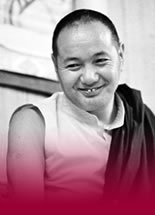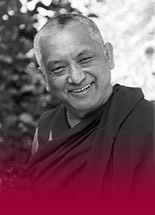Robina’s Blog
22 February, 2024
What we’re trying to do in concentration meditation is train our mind to focus on something – the breath, the mind itself, a visualization – in order to not engage in the thoughts. There are two main obstacles that we go between like drunken sailors in our meditation, which are what prevent concentration.
The one tendency is the mind chatting, chatting, chatting. The other tendency is that the mind spaces out – and it’s a common misconception to mistake this dull state of mind for concentration. No. It can feel nice, but it’s not concentration, it’s not meditation, and is simply the cause of ignorance. It’s a problem. This is why it’s so necessary to know exactly what you’re doing.
In the texts, they refer to these two states as excitement and dullness.
In the classical sutra technique of getting concentration, you train the mind to focus and then catch it when it gets carried away with the excited thoughts, and then you adjust your concentration. And then your mind goes to the other extreme and becomes dull and spaced out, so you have to adjust again. This is the process you’re involved in: adjusting between these two extremes – but not over-adjusting. You’re fine-tuning the mind until it’s sharp and still.
This technique for developing concentration is described in nine stages. As you’re progressing through the first, the second, and the third stages, etc. you’re getting less and less the tendency to be overexcited, and you’re getting less and less the tendency to space out, and you’re getting, therefore, more and more focus, more and more awareness, more and more sharp, clear concentration.
This level of concentration – even the fourth and fifth stages; forget about the ninth – is like science fiction from the perspective of the neuroscientific model of the mind: it’s a subtle level of mind that we don’t even posit as existing. Lama Yeshe talks about it in Mahamudra: How to Develop our True Nature.
So, the two main dangers in concentration meditation are that either the mind spaces out or the mind becomes overexcited.
It’s interesting to notice these same two extremes in daily life, emotionally. Excitement mind is attachment, basically: the mind out of control, never stopping thinking. The other extreme is inertia, lethargy.
However, we can see that there’s something good in both of these states. We know when we’ve got lots of jobs to get done – we go here, we go there, we do this, we do that, we solve this problem, that problem – the mind is very sharp and bright. There’s something good about that sharpness, but at the same time the mind is agitated. This is why it’s hard for us to not go berserk.
We can also see that when the mind is lethargic it’s also quiet. Again, it’s hard to get the quiet without the dullness, the lethargy, the inertia.
The state of concentration that we’re trying to achieve, at whatever level, is a state that is, on the one hand, very calm but not dull, and, on the other hand, very sharp but not excited. It’s really hard to achieve; we never have a mind that’s both sharp and calm. We either have a mind that’s sharp and excited or calm but dull.
And what’s interesting is that as we progress in our development of concentration, the mind becomes more and more joyful – quite literally joyful. This is a surprise.
I remember interviewing Ven. René, the Swiss monk, one of our monks, who’s been in meditation seriously for forty-five years, off and on, in different places around the world. I interviewed him in 1996 for Mandala about his two-and-a-half-year retreat at Osel Ling – the Place of Clear Light – our center in Spain in the Sierra Nevadas near Grenada. His Holiness actually was there in 1982, and blessed it. He named the place. That’s where Lama Osel was born.
Ven. René said maybe he reached the fifth of the nine stages, but the joy, the satisfaction he experienced was a state of mind he’d never experienced before – because it’s not dependent on the senses and because the delusions had calmed down.
And this joy, this satisfaction, is extremely peaceful. When we think of a very happy mind – let’s say through the objects of the senses, especially the sexual one, which is probably the best joy people have – the mind is completely berserk. It’s super agitated: it’s a contaminated joy because the senses are involved and because it’s completely driven by attachment.
Here we’re just talking about mental consciousness, and it’s absolutely peaceful. Not greedy, not grasping, but totally peaceful. This is really what a happy mind means. People who have practiced have a happy mind in daily life. They’re joyful. Not hyperventilating happy because you get nice cakes all the time, but I’m talking about a person who’s practicing virtue, a person who’s given up delusions to some degree, a person who’s disciplined their body and speech.
Joy is the natural state of a mind that is virtuous, a mind that is not attached, not angry, not depressed, not jealous.
When we’ve accomplished some level of concentration in meditation, the mind is incredible. Lama Yeshe talks about it as literally ecstasy, rapture. And not only that: the mind is vast, spacious, clear, beyond the senses, beyond concepts. Normally if we’re beyond concepts and beyond senses we’re fast asleep, snoring!
Of course, this is just the beginning: we can now use this blissful clear mind to realize emptiness, quit suffering and, combined with bodhichitta, achieve buddhahood.
But what a beginning! It’s encouraging to know our potential.

